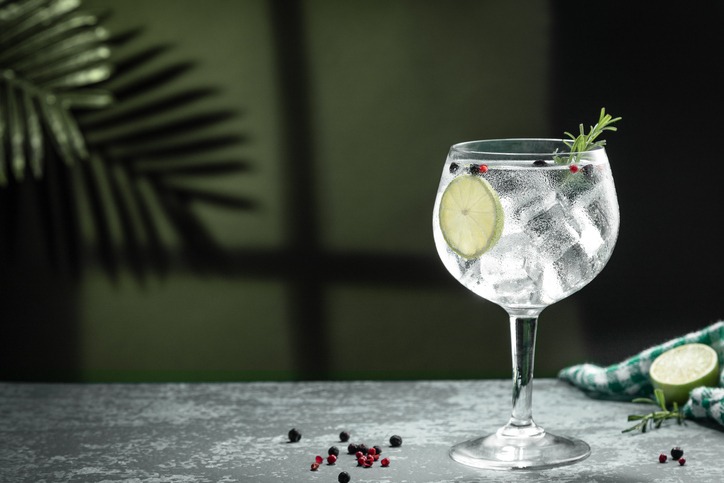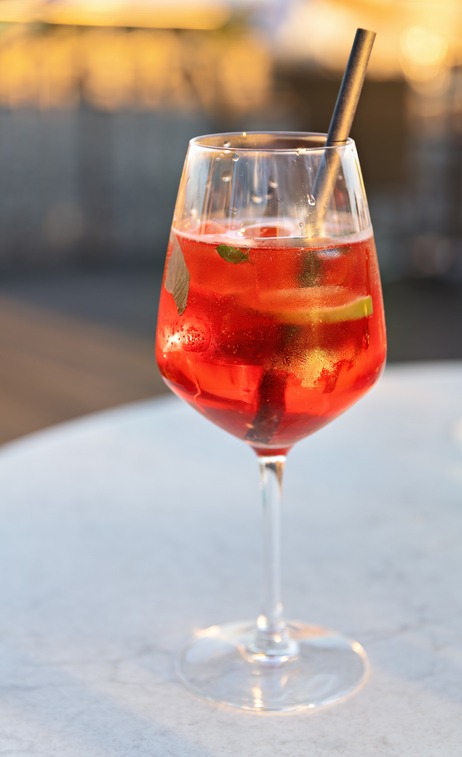A Beginner's Guide to Classic French Aperitifs: Essential Pre-Dinner Drinks

French apéritifs are a beloved tradition in France, marking the transition from work to leisure. This pre-dinner drink ritual typically occurs between 6 and 7:30 p.m. and serves as a moment to unwind and socialize. The custom involves sipping a single beverage, often accompanied by light snacks like olives, nuts, or sliced sausage.
The world of French apéritifs offers a wide array of options. While wine, beer, and champagne are popular choices, there are also unique regional specialties and bartender favorites. Pastis, Lillet, Suze, and Dolin are some distinctive drinks that add flair to the apéritif experience. This tradition embodies the French approach to life, emphasizing the importance of taking time to savor small pleasures and enjoy good company before a meal.
Flavored Island Rum
Rhum arrangé is a tasty drink from French territories far from Europe. It's made by soaking fruit in rum. This practice started long ago to keep rum fresh on ships. Now, it's popular again.
People enjoy rhum arrangé in places like:
- La Réunion
- Mauritius
- Guadeloupe
In 2024, these islands are still part of France. You can also find rhum arrangé in fancy Paris bars.
To make rhum arrangé:
- Pick your favorite fruits
- Put them in rum
- Let it sit for a while
- Chill and drink
The result is a sweet, fruity rum. It's best served cold without mixing. Each batch has its own unique taste based on the fruits used.
A Peachy French Delight
RinQuinQuin is a sweet and fruity aperitif from Provence, France. This low-alcohol drink is perfect for sipping before meals. It's made with white wine and peaches, giving it a bright, summery flavor.
The drink has only 15% alcohol, making it a light choice. People often mix it with tonic water or drink it over ice. RinQuinQuin uses at least three types of peaches in its recipe. The makers also add peach pits and leaves for extra flavor.
After mixing, RinQuinQuin ages in barrels for six months, helping to blend the flavors. The result is a drink that captures the essence of a Provençal summer.
Here are some key facts about RinQuinQuin:
- Origin: Provence, France
- Base: White wine
- Main flavor: Peach
- Alcohol content: 15%
- Aging time: 6 months
RinQuinQuin is best enjoyed chilled or over ice as a pre-dinner drink.
The Classic Kir
The kir is a beloved French aperitif often enjoyed in cafes. This simple yet elegant cocktail combines just two ingredients: crème de cassis and white wine. Traditionally, the wine of choice is aligoté, a local Burgundian variety. The drink gets its deep ruby color from the blackcurrant liqueur.
Making a kir is quick and easy. Pour a small amount of crème de cassis into a wine glass, then top it with chilled white wine. Gently stir to mix the flavors. The result is a sweet and fruity drink with a hint of tartness.
While purists stick to the classic recipe, many variations exist:
- Kir Royal: Uses champagne instead of still wine
- Kir Breton: Swaps wine for cider
- Kir Mûre: Uses blackberry liqueur instead of cassis
- Kir Pêche: Made with peach liqueur
The kir's simplicity and versatility have made it a popular choice for both casual drinks and special occasions.
Picon Beer Mix
Picon bière is a classic French drink that adds a zesty kick to ordinary beer. This mix combines a light beer with Picon, a bittersweet orange liqueur. The typical recipe uses 1 ounce of Picon for every 4 ounces of beer.
Blonde ales are the usual choice for this drink, but pilsners and lagers work well too. The Picon adds depth and flavor to the beer, similar to how cassis enhances white wine.
Picon's exact recipe is secret, but it contains:
- Orange zest
- Gentian (an herb)
- Cinchona bark (source of quinine)
While Picon was first made in Marseille, it's most loved in northeast France and Alsace. Today, the Campari group owns the Picon brand. This unique beer mix offers a tasty twist on regular brews, blending bitter and sweet notes with the crisp taste of beer.
Gin and Tonic: A New French Favorite

Gin and tonic, known in France as "le into," is gaining popularity across the country. French distilleries are creating exciting new gins that are perfect for this classic drink. Citadelle is a well-known French gin brand made by Maison Ferrand. When not making cognac, they use their cognac stills to produce this elegant spirit.
Smaller French gin makers are also worth trying. Bigourdan, based in Arles in the Camargue region, makes a gin with flavors from wild Mediterranean herbs. These include:
- Thyme
- Lavender
- Fennel seed
The "ginto" is becoming a common drink order in bars and cafes from Paris to Provence. It's a refreshing choice for the French apéritif tradition.
St. Germain Spritz

The St. Germain spritz puts a French spin on the classic Italian aperitif. This drink swaps out Aperol for St. Germain, a fragrant elderflower liqueur. The recipe is simple:
- 2 oz St. Germain
- 3 oz Prosecco
- 1 oz sparkling water
- Lemon twist or cucumber slice
Mix the St. Germain with ice, then add Prosecco and sparkling water. Garnish with lemon or cucumber. The result is a light, floral cocktail perfect for warm evenings.
St. Germain comes in an eye-catching art deco bottle that looks great on any bar cart. This French twist on the spritz is an easy way to elevate your next gathering.
Sparkling Natural Wine
Pét-nat has become a trendy choice in Parisian wine bars. This fizzy drink, short for pétillant naturel, offers a fun alternative to champagne. It's made using a simple method: the wine ferments in the bottle, trapping carbon dioxide and creating gentle bubbles.
Pét-nat wines are known for their fruity flavors and often have less alcohol than other wines. They lack the fancy taste of champagne but make up for it with their lively character. Many people enjoy pét-nat for its easy-drinking nature and playful fizz.
Wine lovers can find pét-nat in forward-thinking bars across Paris. It's a great pick for those who want to try something new and exciting in the world of sparkling wines.
Cap Corse: A Corsican Aperitif Tradition
Cap Corse is a beloved aperitif from the French island of Corsica. This unique drink dates back to 1872, when a local wine merchant first crafted it. The recipe blends Corsican muscat and Vermentino wines with cinchona bark extract, giving it a distinctive bittersweet taste.
The drink has a complex flavor profile with floral notes and hints of citrus from Corsican lemon peel. Cap Corse can be enjoyed in several ways:
- Neat over ice
- Mixed with tonic water
- As part of cocktails
Its bold yet balanced taste makes it versatile for different serving styles. Cap Corse remains an essential part of Corsican aperitif culture, embodying the island's rich winemaking traditions.
Pastis: A French Classic

Pastis is a beloved French aperitif with a distinct anise flavor. This strong spirit hails from the south of France, particularly Marseille. Pastis has a unique serving method that transforms it from clear to cloudy.
To enjoy pastis properly:
- Pour a small amount into a tall glass
- Add water (typically 4 parts water to 1 part pastis)
- Watch it turn milky yellow
- Add ice if desired
The drink sparks debate among French people. Many in Marseille love it, while some Parisians may look down on it. Older folks often enjoy pastis while playing pétanque, a popular French game.
Pastis is best sipped slowly on a sunny day. Its strong flavor can be divisive, but many find it refreshing. The key is to try it for yourself and see if you like it. Just remember - never drink pastis neat!
Pommeau: Normandy's Sweet Aperitif
Pommeau is a delightful pre-dinner drink from Normandy, France. It offers a lighter option compared to the region's famous calvados. Pommeau blends fresh apple juice with calvados, creating a sweet and smooth beverage.
The making of pommeau involves aging the mixture in oak barrels for a year. This process adds depth to its flavor profile. The result is a well-balanced drink with hints of tannin.
Pommeau is best enjoyed chilled or over ice. Its lower alcohol content makes it a perfect choice to sip before a meal. The drink showcases Normandy's rich apple-growing tradition in a unique and tasty way.
Lillet: A French Aperitif Classic

Lillet is a French aperitif wine gaining new fans. Made near Bordeaux, it blends wine with fruits and herbs. Lillet comes in white, red, and pink versions. The white Lillet is the most popular.
Many cafes serve Lillet with tonic water. It's also used in famous cocktails. Try it in a Vesper Martini or Corpse Reviver for a tasty drink.
Lillet tastes crisp and floral. It's great before meals to wake up your taste buds. Serve it cold over ice with an orange slice for a simple treat.
Dolin Vermouth
Dolin is a renowned French vermouth brand from Chambery in Savoie. The company has been making vermouth since 1821. Their sweet red vermouth is a top choice for home bars. It's very flexible and works well in many cocktails, including Negronis and Manhattans. It's also good on its own over ice.
The brand got famous in the U.S. thanks to Marie Dolin. She went to the 1876 Philadelphia World's Fair by herself. There, she showed off the family's drinks. Her efforts paid off - Dolin won a gold medal at the fair.
Dolin makes different types of vermouth:
- Sweet red vermouth
- Dry vermouth
Both are key ingredients in many classic cocktails.
Pink Perfection: The Allure of Rosé
Rosé wine holds a special place in French aperitif culture. This pink-hued beverage shines brightest when enjoyed on its own, away from the dinner table. Many rosés, especially those from Provence, boast delicate floral and fruit notes that can be lost when paired with food.
Rosé truly comes into its own during hot summer days. It's the only wine where adding ice cubes is not frowned upon. In fact, at fancy beach clubs in Nice, you might be given a small ice bucket and tongs to chill your glass to your liking.
While dry white wines are common aperitifs, rosé offers a unique experience. Its refreshing taste and pretty color make it perfect for sipping before a meal. Whether you're lounging by the sea or enjoying a city terrace, a chilled glass of rosé captures the essence of leisurely French living.
Suze: A Bold French Bitter

Suze is a unique French aperitif with a striking yellow color. This gentian-based drink packs a powerful punch of flavor without being too strong in alcohol. At 15% ABV, it's perfect for a relaxed pre-dinner sip.
The taste of Suze is hard to pin down. It's bitter and almost medicinal, yet refreshing at the same time. It's not quite sour or citrusy but has its own distinct character.
To enjoy Suze:
- Serve over ice with a splash of soda water
- Mix with tonic for a twist on the classic G&T
- Use in cocktails for an extra bitter kick
Suze shines when its bold flavor takes center stage. It's an ideal choice for those who appreciate complex, bitter tastes in their drinks.
Pineau des Charentes

Pineau des Charentes is a unique French drink that blends cognac and grape juice. It's made only in the Cognac area, following strict rules. This special mix was the first fortified wine to get official protection in France.
There are three types: red, white, and pink. Young Pineau des Charentes tastes fresh and fruity. As it ages, it gets hints of honey and dried fruit.
To serve, cool it a bit, but not too much. Pour it into a small wine glass or a tulip-shaped glass. This lets you enjoy its smell and taste best.
- Types:
- Red
- White
- Pink
- Taste changes with age:
- Young: Fresh and fruity
- Old: Hints of honey and dried fruit
The Sweet Fizz of Le Diabolo
Le Diabolo is a beloved French drink that brings joy to both kids and adults. This simple yet delightful beverage mixes syrup with sparkling lemonade, creating a fizzy treat perfect for warm evenings.
The most popular version is Diabolo Menthe. It stands out with its bright green color and refreshing mint flavor. Another favorite is the red-hued Diabolo Grenadine, made with pomegranate syrup.
You'll often see families enjoying these drinks at outdoor cafes around 7 p.m. Kids sip their colorful Diabolos while adults indulge in more grown-up options. It's a charming scene that captures the essence of French social life.
Here are some common Diabolo flavors:
- Mint (Menthe)
- Grenadine
- Strawberry
- Lemon
- Peach
Le Diabolo is more than just a drink - it's a taste of French culture in a glass.




